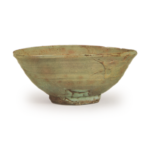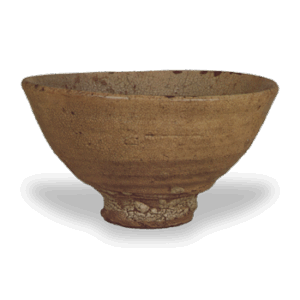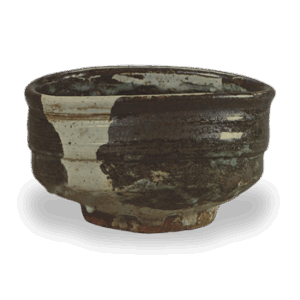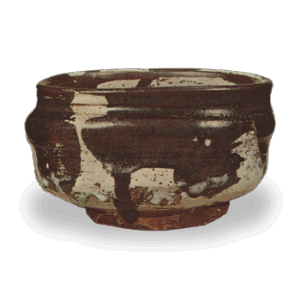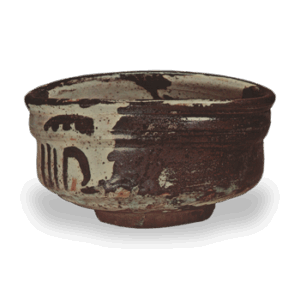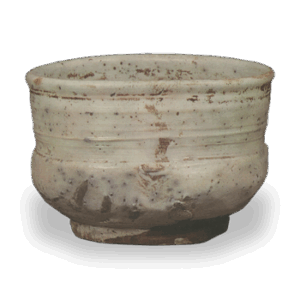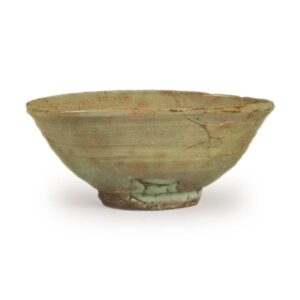
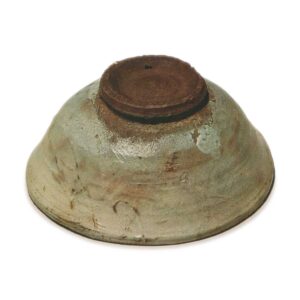
Height: 6.2 – 6.7 cm
Diameter: 13.9 – 14.9 cm
Outer diameter of foot: 5.7 – 5.9 cm
Height: 1.0 cm
This is a sturdy bowl with a flat, thick body. The pale yellow ground has a subtle red band, and the name “Shinonome” (dawn) was probably given because of this appearance.
The body is a hard, semi-porcelain material with a slight iron content, and it is covered in a thick, transparent glaze with a slight bluish tinge. The glaze is particularly thick from the waist to the side of the foot, and the foot is not glazed, but is stained with tea and has a dark brown color. There are no cracks in the part of the surface that was well-fired, but there are some cracks in the part of the underside that was not well-fired, and the glaze is rough in the thick areas and fine in the thin areas.
The shape is flat with a wide mouth, and a large, low foot ring supports it. The rim is called hikippashi, which means “pulled straight”, and it is the shape of the rim as it is pulled straight on the potter’s wheel, with no leather or cloth applied to the rim. It also has an uneven rim, which is called yamamichi, and is not often seen. The foot ring is made of a low bamboo joint, and the spiral-shaped marks on the underside of the base clearly show that the potter’s wheel was turned to the left. The middle of the pot is shaped like a helmet, and the thick rim gives it a rugged appearance. When viewed from above, it is not a perfect circle, but is distorted and elliptical, and the inside is deep, with a spiral-shaped dent in the middle, and six indistinct eye sockets around the inside. Looking at the body, it is made by coating it with a sticky mud that is commonly called “dobe”, but it is clear that the dobe clumps have come off and stuck together in two or three places, and that the water-drawing is left-handed.
The firing was slightly reductive, and the overall color is a light blue-gray, but there are also patches of a very faint reddish color on both the inside and outside. The outside is a vague reddish color in a banded pattern, and the name “Shinonome” probably came from this. On the inside, there are faint reddish spots scattered in a dappled pattern.
The surface of the ware is well-fired, and in the thickly glazed area by the foot of the rim, the kaaragi pattern has appeared and is beginning to melt, revealing a beautiful powder blue color. On the other side, the glaze has not melted well, and the glazed surface is slowly emitting a dull sheen. In addition, the area by the foot of the cup is stained brown by tea stains. Overall, it is a heavy, solidly-made teacup that is excellent for use in the tea ceremony.
The origin of this tea bowl is unknown. There is only a piece of paper tied to the string of the outer box with black ink that says “Among the 13 tea utensils that were sent from Hachobori on April 12th, 1845”. There is a piece of paper with a collection seal attached to the outer box, but it has been scratched off with a fingernail to hide the name of the original owner. The inner box is made of plain paulownia wood, and on the underside of the lid are the two characters “Tōnebi” written by Prince Konoe Yoshihiro. The outer box is made of lacquered paulownia wood, and on the upper right is the character “Kokente” in gold powder, and on the lower right are the five characters “chawan”. The author is unknown.

